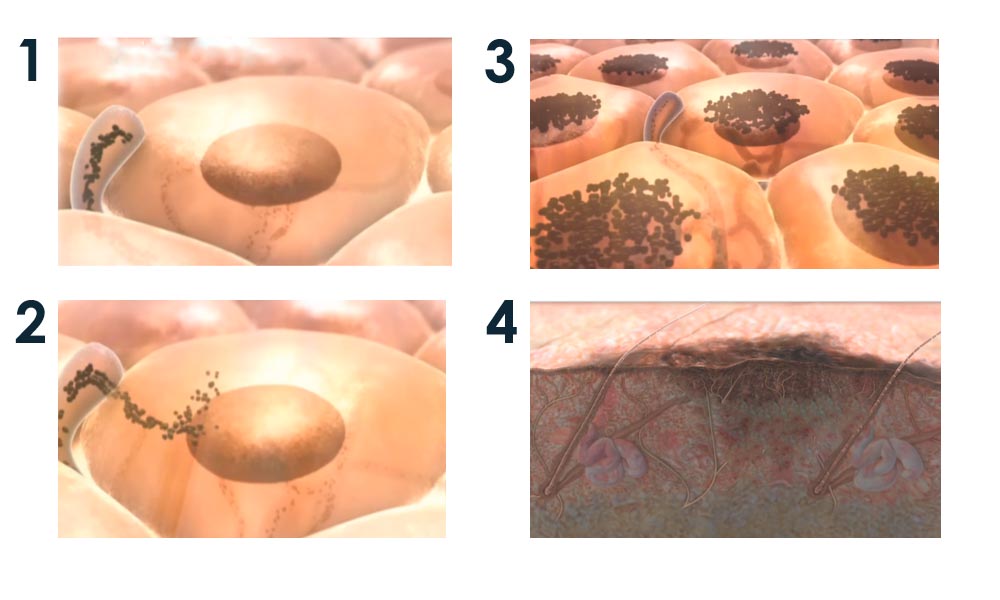Melasma
Advanced solutions to treat melasma in a targeted and effective way.
Examples of Post-Melasma Treatment Results

Our Approach to Treating Melasma
1
In-depth consultation with advanced imaging to assess skin concerns and create your personalized treatment plan
2
Proposed treatment plan tailored to the severity of your melasma
3
Start of treatments followed by a post-treatment follow-up to ensure their effectiveness.
Understanding Melasma
Melasma is a specific form of hyperpigmentation caused by an excessive and disorganized production of melanin, concentrated in certain areas of the face. It typically appears as diffuse, symmetrical brown patches, most commonly on the cheeks, forehead, nose, or upper lip.
Melanin is a natural pigment produced by melanocytes, the cells responsible for the color of the skin, hair, and eyes. All humans have a similar number of melanocytes, regardless of skin tone. What varies is their level of activity. You can think of them as tiny “pigment faucets” that open or close depending on factors such as sun exposure, hormones, or inflammation.
In the case of melasma, these faucets remain partially or fully open for prolonged periods, leading to a buildup of pigment on the skin’s surface. This imbalance can be triggered by:
- Chronic sun exposure (the main factor)
- Hormonal changes (pregnancy, birth control, hormone treatments)
- Genetic predisposition
- Inflammatory reactions or skin sensitivities
Types of Melasma
- Post-inflammatory hyperpigmentation (e.g., after a pimple or irritation)
- Hormonal melasma
- Pregnancy mask
- Chronic age-related pigmentation spots
How Melasma Forms in the Skin

Possible Causes of Melasma
- Chronic sun exposure without adequate protection.
- Hormonal fluctuations (menstrual cycle, contraception, menopause).
- Pregnancy (pregnancy mask or chloasma).
- Use of hormonal contraceptives or hormone replacement therapy.
- Genetic or hereditary predisposition.
- Inflammatory reactions or skin sensitivities (e.g., after a peel or inappropriate treatment).
- Use of certain photosensitizing medications.
- Overstimulation of melanocytes due to internal or external factors.
Our Approach to Treating Melasma
Melasma is a complex form of hyperpigmentation that requires a highly personalized approach. The first step in our process is an in-depth skin analysis to determine the depth, distribution, and exact cause of the pigmentation. While melasma is often triggered by sun exposure, it can also be linked to hormonal fluctuations, pregnancy, photosensitizing medications, or genetic predisposition.
With our advanced 3D imaging system, we can visualize pigment structures beneath the skin’s surface. This technology allows us to evaluate melanin concentration across the different skin layers and observe the impact of inflammation or other aggravating factors. This level of precision enables us to design a treatment plan tailored specifically to your type of melasma whether epidermal, dermal, or mixed.
It’s important to understand that melasma treatment is not based on a single device or one-size-fits-all protocol. Some lasers, when misused, can overheat the skin and worsen hyperpigmentation. An effective melasma treatment must consider underlying inflammation, skin sensitivity, and the mechanisms of recurrence.
We often welcome patients who have previously undergone treatments at other clinics frequently using inappropriate technologies such as IPL (intense pulsed light), which may temporarily lighten spots but does not offer lasting stabilization of melasma. In some cases, poorly targeted treatments can trigger a rebound effect, resulting in darker pigmentation than before.
Our approach is grounded in a deep understanding of pigment biology and the combined use of gentle, progressive, and complementary treatments. Depending on your skin profile, this may include:
- Melanin-regulating medical peels
- Prescription topical treatments
- Gentle non-ablative low-density lasers
- Anti-inflammatory and regenerative therapies (such as exosomes or PRP)
- Strict sun protection tailored to your phototype
With over 40 medical and aesthetic technologies available at Clinique Infinium, we have the flexibility to apply the right tool at the right time, based on your skin’s response. Each treatment plan is progressive, safe, and designed to deliver visible, lasting results while minimizing the risk of relapse.
Melasma is a chronic condition, but when treated properly, it can be significantly reduced. Our goal is to restore a more even, stable, and healthy complexion — without causing unnecessary irritation. Because every pigmented skin deserves expert, personalized care that respects its unique sensitivity.




